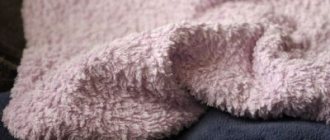- What fabrics shrink after washing?
- How to prevent clothes from shrinking after washing
- What to do if clothes shrink after washing
Shrinkage is typical for clothes made from natural materials. Any natural fibers change their properties, swell and twist after washing.
Knowing that natural fabrics shrink when wet, manufacturers take this feature into account during production, leaving the necessary allowance for the product to shrink. This should be taken into account when choosing clothes: you should not take things made of natural cotton, viscose and linen that fit snugly; the item should be a little loose.
In order to understand the reason for the deformation of the canvas after exposure to moisture, it is necessary to know the composition of the material. Any fabric consists of a weft and a warp. The warp threads are parallel to each other, and the weft threads are woven into them and intertwined with each other. The density of the fabric depends on how far apart the threads are located.
There are several main reasons why clothes shrink after washing:
- Elastic deformation. In order for the scattered threads to become a piece of fabric, a huge amount of work is carried out. The fibers are processed, bent and stretched many times, so they remain in “tension”. When water gets on them, the threads “relax” and the clothes shrink. Most often, shrinkage after washing occurs along the warp threads, the weft fibers undergo elastic deformation less often.
- Swelling of fibers. Threads made from natural materials are porous and hygroscopic. This means that they are able to absorb moisture and increase in size. If the fabric is not dense, then there are gaps between the threads that fill when it swells. In materials of medium and high density, deformation can occur due to a sharp increase in specific density. In simple terms, the swollen fibers do not have enough space and become intertwined and twisted with each other.
Proper care of the fabric will ensure long life and excellent appearance of things. Always pay attention to the symbols on the label. These pictograms will tell you whether clothes or bed linen can be washed in a machine, at what temperatures, at what speed they can be wrung out and how to dry them properly. Washing at temperatures higher than recommended and excessively curling can cause clothing to shrink a size or several.
Clothes shrink the least when washed by hand. You should choose this one if there are few things or the dirt is small. Soak the product in slightly warm water and rinse. Squeeze a little with your hands or let the excess liquid drain on its own. Depending on the composition of the fabric, choose horizontal or vertical drying.
Reasons for shrinkage
Shrinkage is a change in the size of fabric under the influence of moisture. The product may shrink not only in direct contact with water or steam, but also under the influence of precipitation or high air humidity. True, in these cases the process does not occur so quickly and the clothes do not have time to become greatly deformed.
Fabrics can shrink at various stages of production: during cutting, sewing, or even during storage if it is not carried out properly. As a rule, in these cases, the amount of deformation is provided and taken into account when sewing products.
A much greater nuisance is the shrinkage that occurs during clothing use, since it is not possible to cope with it in all cases. The reasons for changes in the size of products after wet-heat treatment are as follows :
- The appearance of reversible elastic deformation. During the textile production process, the threads of the fabrics are subjected to repeated stretching, as a result of which they are, as garment workers say, “under tension.” During the dyeing stages, to ensure maximum impregnation, the materials are pulled onto special spreaders, and so-called elastic deformation appears in the product.
During the first wet-heat treatment, the tense fibers are weakened and the fabric shrinks. Moreover, in most cases, the product decreases more strongly in size not along the weft threads, but along the warp threads.
- Swelling of threads. By absorbing moisture during washing, soaking or steaming, fabric fibers also relieve tension. At the same time, they not only shorten, but also bend, as a result of which the clothes take on bizarre shapes. This process is especially strong in knitted fabrics.
Shrinkage is a very unpleasant phenomenon that requires extra costs from manufacturers. When cutting materials, craftsmen are forced to make allowances, which increases fabric consumption and does not always lead to the desired results.
The degree of shrinkage distinguishes not only different fabrics, but also the same material in different parts of clothing, depending on their size, the shape of the patterns and the number of stitches. Thus, small parts with frequent seams, for example, sleeves, collars or pockets, “shrink” more than large panels.
It happens that when sewing mixed fabrics that are not subject to changes in size, cotton threads are used. As a result, after washing, the product gathers unattractively at the seams and loses its attractive appearance.
General washing principles
Wool belongs to the category of delicate fabrics. There is no need to treat it aggressively so as not to damage the fiber structure and deform the product. With the help of some folk remedies you can take care of woolen items for a long time. Often the products are washed by hand and cannot withstand squeezing. You can also clean woolen items in an automatic washing machine, but only in the appropriate mode. There are several tricks you need to know to keep things sparkling clean and not spoiled.
- To prevent fluffy items from matting, you need to comb them before immersing them in water. These manipulations also allow you to remove heavy dirt.
- After reviewing the information from the manufacturer, you need to select the temperature mode. Before washing, wool products must be turned inside out.
- Things need to be sorted before being placed in a basin or drum. Good quality natural wool is not subject to shedding, but it does lose lint. If it sticks to other things, it is very difficult to remove the particles.
- There should be no sudden temperature changes when washing. This destroys the delicate fibers. Exposure to contrasting water is permissible only for the purpose of slight shrinkage when the item is large. Frequent manipulations of this kind will quickly render the product unusable.
- You need to be very careful when choosing detergents. There are specially developed lines of powders and gels that are aimed at thoroughly cleaning delicate fabrics and maintaining their attractive appearance.
How to wash woolen items so that they last as long as possible. You must follow all rules and follow the information on the label. For hand washing, individual nuances are provided.
Shrinkage of various fabrics
The amount of shrinkage of textile materials depends on several factors, including their composition. Fibers that shrink the most are those that can absorb the maximum amount of water and change their size when wet. Such fabrics include cotton and linen materials, as well as viscose.
The swelling of the fibers increases with strong twisting, which is very typical for wool and some silk fabrics. In this case, not only the diameter of the yarn changes greatly, but also the structure of the fabric itself.
There is a system of standards that provide for percentage shrinkage of various materials. Here are the values for the most common fabrics:
- Cotton: tartan, corduroy – 5-6%;
- Satin, chintz, poplin, percale – 3-5%;
- Linen fabrics – 6-7%;
- Wool blend – 3-4%;
- Wool – 6-7%;
- Silk smooth – 4-5%;
- Staple and viscose - 3-4%.
Interesting fact! When synthetic fibers are added to natural ones, their shrinkage ability decreases. But one should not think that synthetics are completely immune to this flaw. Even nylon products shrink up to 1.5% after washing, and semi-nylon products shrink up to 2.5%. Many cushioning materials, for example, dublerin and non-woven fabric, suffer from the same drawback.
Handwash
Manual processing is the best option for caring for items made from delicate fabrics. If possible, using this method will significantly extend the life of things.
For completely manual processing, the washing order should be as follows:
- Pour water into the basin with a temperature no higher than +30ºС.
- Dissolve the detergent.
- Immerse the clothes in the basin.
- Leave for 30 minutes.
- Wash carefully - not by rubbing, but by massaging movements.
- Rinse - in several changes of water or under a running stream.
After washing, the water should be allowed to drain freely without spinning. Twisting and squeezing into a lump can lead to the formation of strong creases, which will be very difficult to remove.
Pre-soaking is not a mandatory washing step and can only be used if the clothing items are significantly soiled.
Anti-shrink treatment methods
They try to prevent shrinkage and deformation of fabrics or, at least, reduce them in the stages prior to sewing clothes. There are special methods for this:
- mechanical. An elastic band is placed on the fabric and pressed tightly. In this form, the material is rolled through hot rollers. As a result, the tension is removed from the tape, and the fabric undergoes forced shrinkage;
- chemical. Its essence lies in the preliminary impregnation of the fibers with a solution of formaldehyde, which reduces their swelling when exposed to moisture, and consequently, deformation;
- tracking. This method is most often used for knitted materials. Rolls of fabric are laid out on shelves in a room with a given humidity and left for a long time. After the shrinkage process is completed, the canvases are put into production.
The most effective methods of anti-shrink treatment include heating with dry steam and decating. Let's learn about this method in more detail.
Knitwear, viscose, polyester
Making clothes the right size by shrinking them is not difficult, especially if it is knitwear. It is advisable to follow the same rules as when washing the above materials. You can understand how to wash knitted items by reading the clothing labels. When polyester is added to knitwear, shrinkage will be difficult, but this is possible if hand washed in very hot water.
It will not be possible to make sizes 40-42, but it is possible to shrink knitted items as much as possible by washing them at 60°C.
How to wash viscose so that it shrinks? If polyester is also added to such a sweater, it will be very difficult to reduce it when washing correctly. A washing machine will also help make a velvet dress smaller. It also needs to be rinsed properly. It is advisable to do this at low temperatures, with virtually no squeezing.
What is the reason to shrink leather pants or tops? It is believed that such things do not stretch, but fit to the figure. But if a lady has suddenly lost weight, a specialist in the studio will help make them smaller. It is better to sew a dress or pants correctly than to wash them at a merciless 90°C. This will greatly ruin the dress.
It is very difficult to shrink polyester properly. If knitted items can be made 2-3 sizes smaller, just like velvet, then polyester and viscose - rayon - are not easy to reduce. It is advisable to simply contact specialist seamstresses and sew the item correctly.
Viscose is never the only thing. This component is always mixed with polyester, knitwear, and other natural fibers. You can reduce them correctly without subjecting the item to boiling or other manipulations.
It is important to remember that polyester is a very insidious material. If you mishandle it when washing, you can say goodbye to the item.
Knitted items quickly become pilled when washed at 60°C. Even if you rinse in ice water
Therefore, you need to be especially careful when affecting knitted trousers or T-shirts. In addition, they can shed easily
Viscose is not so capricious, but in combination with other components it can become very unpredictable. It is better to wash knitted trousers and T-shirts of the same color together. You should not combine velvet and knitwear, as well as polyester.
A good housewife will not throw away a very stretched item. Even knitted trousers can be sewn in or manipulated in the wash. Velvet is more delicate than polyester, but it is not something to be trifled with. The item may become unusable and fade 100%.
So, knitted items and those made from polyester and viscose, wool, cotton must be shrinked very carefully. It is advisable to first show the item to a specialist who can understand what material it is made of.
Based on this, it is permissible to make any attempts at shrinkage. It is recommended to do everything according to the standards and not wash wool items at 90°C. This will cause an unpleasant shrinkage of 5-6 sizes. Especially if the sweater or coat was machine washed
It is important to follow all directions on the labels.
https://youtube.com/watch?v=-M-5CUL80WY
Decatation of fabrics
This is an artificial shrinkage of canvases, carried out using their wet-heat treatment. All fabrics that contain more than half of natural fibers are decatified.
To determine at home whether the material needs descaling, you should iron a small area with a hot iron. If the fabric has subsequently changed its size, then pre-treatment is required. Let's consider methods of decating fabrics of different compositions.
Cotton fabrics
It is enough to iron these materials with a hot iron from the wrong side, slightly moistening them. Just first make sure on a small piece that after this there will be no streaks left on the canvas.
Cotton should only be ironed along the grain. Instead of a spray bottle, you can use an iron with a steamer.
Linen materials
Linen is highly susceptible to shrinkage, so the linens are soaked or washed in cool water and lightly wrung out. Then the fabric should be dried a little.
The wet material is ironed from the wrong side, carefully ironing out all folds and creases. Linen cushioning fabrics are dried by laying them out on a horizontal surface. Ironing is not necessary for them.
Wool and wool mixture
These fabrics are moistened with a solution of water with table salt and vinegar and wrapped in a thick towel. They must remain in this form for at least 10 hours. At the end of the procedure, the fabric is folded along the grain thread with the right side inward, carefully aligning the edges. After this, it is ironed through cotton fabric, moving the sole of the iron in the direction of the main thread.
Natural silk
They, like woolen materials, are moistened with a vinegar solution and slightly dried, avoiding direct sunlight. Then fold it in half and iron it along the grain from the inside out using a cotton backing.
The crepe is soaked in a weak solution of gelatin (1 teaspoon per 2 liters of water), after drying slightly, smoothed out in a similar way.
Artificial fabrics
Viscose and other cellulosic materials can shrink significantly during the first wash. Therefore, like natural ones, they are subjected to pre-treatment.
The fabric is wrapped in a damp sheet and left for 3-4 hours, after which it is ironed on the reverse side. To prevent discoloration, you should check the fastness of the dyes on a small fragment.
Synthetics
Before cutting, these materials must be ironed, moistened with a spray bottle. Bright colored canvases are pre-tested for color fastness.
It is especially important to decatify fabrics that contain lycra. These materials tend to shrink greatly after washing. Therefore, wet processing will make sure that the elastic fabrics will not lose their characteristics during operation and the product will not subsequently change shape.
It is important to know! After decating the fabrics, you need to cut off a few centimeters at the edges. The reason is that the edges “sit” less than the main fabric, and an unwanted distortion may appear in the finished product.
Why shrink a knitted item?
The reasons why a knitted item needs to be shrunk are quite varied:
- it may be the wrong size - for example, a sweater bought without trying on turned out to be too big;
- it may be too thin - and shrinkage will slightly compact the product;
- mistakes may be made when washing and drying the product;
- it may stretch when used.
Most often, clothes have to be resuscitated precisely for the latter reason. Natural fabrics, in addition to all their undoubted advantages, also have a disadvantage - they easily stretch and lose their shape. It's a shame when your favorite thing suddenly turns into a shapeless, unevenly stretched bag. This is where our advice can come to the rescue.
How to eliminate shrinkage
In order to prevent the finished product from shrinking, before washing or ironing, you need to carefully read the composition of the fabric and the care instructions, which are located on the label in the form of icons. If a sweater, jacket or dress is already deformed, then you can try to return it to its original size. Experts recommend using the following methods:
- The textiles are soaked in cool water for 1-2 hours, and then lightly wrung out and laid out on a flat surface. To prevent drying quickly, cover the product with a terry towel. The shrunken parts are stretched and secured with clothespins. As it dries, the clamps are rearranged, increasing the tension.
- You need to mix equal amounts of water and ammonia. Leave the clothes in the solution overnight, then wring out, stretch and lay out to dry.
- If the degree of shrinkage is insignificant, then you can do without water. The product must be ironed through cotton fabric with a hot iron in steam mode. In this case, deformed parts should be straightened from time to time.
- Jeans that have shrunk after washing can be restored to shape by washing them in cool water and then drying them by running a hot iron along the inside in the direction of the desired stretch. When the fabric is only slightly damp, you need to put on the trousers and sit down in them several times. After this, your favorite pants will return to their original size.
Interesting to know! There is another way that will help save a thing that has become stuck. Put a damp and slightly dried sweater or T-shirt on yourself and dry it in this form. After complete drying, the clothing will return to its original shape.
It is also worth mentioning that lost size can only be restored to fabrics that contain cotton or synthetic fibers. Unfortunately, shrunken sweaters and cardigans made from 100% wool cannot be restored.
Developing rapidly, the modern textile industry pleases us with new beautiful fabrics every year. To avoid unpleasant moments that may arise during the operation of products made from them, you should carefully study all the properties of the materials.
Nuances that can ruin a thing completely
The following can be detrimental to a knitted item:
- ironing;
- drying on a rope or radiator.
In these cases, the canvas may become deformed in such a way that it will be impossible to correct it.
Drying on a radiator is detrimental to knitted items
Video: how to irrevocably ruin a wool item
I once bought a synthetic sweater. I was still quite an inexperienced housewife at that time. I washed it by hand and hung it on a line to dry. As a result, I ended up with something very long. I had to think about what to do with this. Fortunately, either short dresses or what they now call tunics (I didn’t know such words then) came into fashion. In general, I found a matching belt, and simply turned the sleeve cuffs inside out and inserted an elastic band into the lower part. I want to say that I wore this mini-dress for quite a long time and was glad that I had come up with a second life for my mistake.
Why do things made of wool tend to shrink?
Natural fabrics have this feature; synthetic clothing always stays true to size. Capable of shrinking cotton and wool items, especially with regard to the first wash. This is a reaction of natural fibers to moisture and temperature, so if you don’t follow the rules, your favorite sweater will become 1-2 sizes smaller after washing. This problem is caused by a number of reasons:
- Temperature rise above 30 degrees.
- Using standard powder with a large number of chemical components.
- Incorrect mode selection. Washing wool products requires the use of a special function with delicate operation.
- Vertical drying on a clothesline.
- Exceeding spin norms by more than 300 rpm.
- Drying on artificial heat sources: battery, radiator.
When restoring woolen items, you need to read the instructions for washing them and do the opposite. You just need to act carefully, without going to extremes.
To minimize the risk of product damage, it is recommended to work according to the following scheme:
- First, soak the affected sweater or hat in hot water. The duration of the stage should not be more than half an hour. The fluid temperature is set approximately 20 degrees higher than what is indicated on the label.
- After the specified time, rinse the woolen item using very cold water, you can even add a few pieces of ice to the liquid. A properly organized temperature difference can do a significant part of the work.
- Wrap the washed wool in a dry and warm terry towel. Remove excess moisture with blotting movements. Twisting woolen items is highly discouraged, especially a sweater, dress or jacket.
- Next, the clothes are dried. We lay hygroscopic fabric on a dense horizontal surface without visible relief. Lay a sweater or other item on top. It is advisable to direct flows of artificial heat onto the wool, then the shrinkage will be more dense. During drying, you need to give the item the desired shape with your hands, regularly adjusting the material so that it does not stretch.
Washing in a machine also causes strong shrinkage, but it is very difficult to control the process. As a last resort, a stretched sweater can be washed in a special mode for wool or hand washed, but the result can be unpredictable.
Such products also fit very well. But they cannot be washed in a machine, as there is a chance that after washing your item will only fit on a child. For optimal fabric shrinkage, proceed as follows:
- Soak the desired item of your wardrobe in water, which should be 20 degrees hotter than indicated on the label.
- After 1 hour, wash by hand with powder.
- Rinse in cold water.
- Place, without twisting, on a clean cloth.
If your woolen item is clean, it’s winter outside, and you urgently need to reduce it by 2-4 cm, then you can use this method:
- Wet your clothes.
- Hang to dry on a hot radiator with a cloth underneath.
We wash the silk so that it shrinks
Natural silk is an elite and expensive fabric. Clothes, bedding and interior items are made from it. For many silk products, manufacturers recommend hand washing at 30 C°. For washing in a machine, use the “Delicate Wash” and “Silk” programs. Clothes are dried away from sunlight to maintain the appearance and shape of the clothing. In order for silk clothes to shrink, wash them at 40 C° and spin 400 rpm. Dry in the sun. Be prepared for the fact that colored silk may fade. If you are afraid of ruining an expensive silk product by washing, contact a studio.
If your favorite clothes have stretched out after washing, use the recommendations presented in the article. Share your new proven methods for shrinking fabric in the comments to the article.











